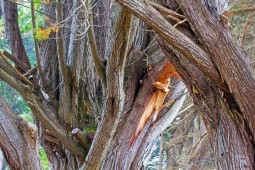 As a homeowner, you take pride in your yard, whether it has a beautiful flower garden or a strong, sturdy tree. While these landscaping accessories are beautiful, they do not last a lifetime. For this reason, it’s not always in your home’s best interest to leave dead or dying plants and trees alone. They can become a danger to you, your family, and your home. Learn more about the signs that signify it’s time to get rid of an aging tree.
As a homeowner, you take pride in your yard, whether it has a beautiful flower garden or a strong, sturdy tree. While these landscaping accessories are beautiful, they do not last a lifetime. For this reason, it’s not always in your home’s best interest to leave dead or dying plants and trees alone. They can become a danger to you, your family, and your home. Learn more about the signs that signify it’s time to get rid of an aging tree.
- Shape. If your tree is leaning an excessive amount, then you should look into having the tree removed. While trees normally do not grow perfectly straight and usually have a slight lean, your tree should still not be tilted over to the point where it’s at risk of falling over and possibly damaging your family or house.
- Fungus. If you notice the trunk of the tree is rotting or has fungi growing along the base, it’s time to have it removed. Don’t be alarmed if you notice mushrooms, as they are not all linked to root diseases. Fungus is an indication of internal rot and should be reviewed by a professional right away.
- Branches. While checking the trunk of the tree is important, you should also keep an eye on its branches. If you notice that one side of the tree is full of dead branches, that side probably also has root or trunk damage. If a majority of the branches are crossing or rubbing, they will be more prone to splitting and falling. Take note of the tree as a whole as well; if the branches look dry and you notice a lot of debris, it’s time to have the tree removed.
- Species. If you notice that the tree is prone to frequent damage or sheds an excessive amount of debris, this could mean that you have an undesirable species of tree. These trees are made of weak wood and are often infested with diseases or insects. Trees like Silver Maples grow quickly but have weak trunks and branches; Lombardy Poplars are prone to disease and have been known to have issues with bugs; Eucalyptus trees are beautiful, but known for dropping heavy, resin-filled branches unexpectedly. Research the tree in your yard to uncover any hidden dangers or issues associated with that species.
- Trunk. Pay attention to the tree’s trunk and inspect it for cracks or cavities. A cavity is a hollow or hole formed in the trunk or branches, commonly found in old or dying trees. A cavity could mean the tree is no longer structurally stable. If you spot anything out of the ordinary, like rotting, cavities, or missing pieces of bark, it’s time to have the tree removed.
Overall, trees are great for your property when they’re healthy, but they can become dangerous to your family or home as they die. If you have any concerns about the trees in your yard you should contact an arborist right away to have them evaluated.
This post brought to you by Clauser Tree Care, a tree removal company in Chalfont, PA.
